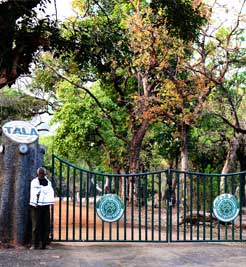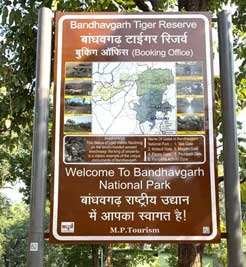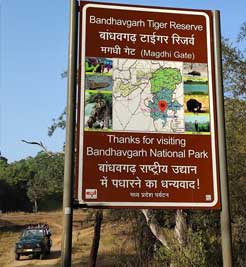Best Safari Zones in Bandhavgarh
Bandhavgarh National Park, renowned for its stunning landscapes and diverse wildlife, is one of India’s premier safari destinations. Spanning across the Vindhya hills in Madhya Pradesh, the park is home to a significant population of Bengal tigers, along with a rich variety of flora and fauna. The park is divided into core and buffer zones, each offering unique opportunities for wildlife enthusiasts to explore and experience the natural beauty of the region. Whether you are seeking thrilling tiger sightings or a serene escape into nature, Bandhavgarh’s safari zones cater to all adventure seekers.
Core Zones
The core zones of Bandhavgarh National Park, including Tala, Magadhi, and Khitauli, are renowned for their high density of tigers and rich biodiversity. These areas provide prime opportunities for wildlife sightings, particularly during jeep safaris. The central region of Bandhavgarh National Park is marked as the core zone.
Buffer Zones
The buffer zones, such as Dhamokar, Johilla and Panpatha, offer a more tranquil wildlife experience, allowing visitors to appreciate the park's natural surroundings without the crowds. These zones are ideal for nature walks and birdwatching, featuring a diverse range of flora and fauna. The buffer zone of Bandhavgarh National Park surrounds the core zone of the national park.



Core Zones of Bandhavgarh National Park
Tala - Tala is one of the oldest and most renowned zones within Bandhavgarh National Park. In addition to its exceptional tiger sightings, this zone features several notable attractions, including the historic Bandhavgarh Fort and the 10th-century Shesh Shaiya, which depicts an idol of Lord Vishnu reclining on the serpent Shesh Nag. This idol is the source of the Charan Ganga, a river that sustains the park's diverse ecosystems and meadows. The name Charan Ganga is derived from its origin at the feet of Lord Vishnu. Another significant site in the zone is the Bari Gufa, also dating back to the 10th century. Prominent meadows such as Rajbhera and Chakradhara are renowned for remarkable wildlife sightings. Additional attractions include Bamania Hill, Three Cave Point, Sita Mandap, Gopalpur Pond, and Ketkiha. The region is characterized by lush Sal forests, grasslands, and hillocks, with Umaria being the nearest town located 32 kilometers from the Tala zone.
Magadhi - The Magadhi Zone of Bandhavgarh National Park features several natural and artificial waterholes, including Murdhawa, Dabhadhole, Sukhi Patiha, and Charkpwaha, where tiger sightings have frequently been reported. The area is characterized by a mix of dense forests and open grasslands. In addition to its wildlife, the zone is notable for various attractions such as Charger Point, Mahaman Pond, Climber’s Point, Sookhi Taalab, Sookhi Dam, Dinosaur Rock, and Sehra Dadra. Located on the periphery of the park, this zone is easily accessible from Umaria, situated just 38 km away.
Khitauli - This zone, of Bandhavgarh National Park is characterised by dry deciduous forests and has reported numerous tiger sightings in recent years. It is also home to a herd of migratory wild elephants. In addition to tigers, visitors may encounter other wildlife, including nilgai, chinkara, and chausingha. The zone is increasingly popular among birdwatchers as well. Notable attractions within this area include the Umrar River, Garhpuri Dam, Nilgai Nala, Kumbhi Kachhar, Charkhi Dongri, Marjadgarh Tower, and Tedka Munara. Located just 37 km from Umaria, Khitauli is easily accessible by cab or private vehicle.
Buffer Zones of Bandhavgarh National Park
Dhamokar - Located 14 km from the Tala Zone, this buffer area serves as an extension of the Magadhi Zone and is located between the villages of Parasi and Mahaman. Notable attractions in the zone include the Mudgudi Dam and several natural caves known as Sehimaada. The Kadewaha grassland provides an excellent setting for wildlife observation within this region.
Johila (Kalwa) - The Johila or Kalwa Zones is an extension of the Tala Zone. The entry point to this area is situated near Chechpur village. The Johila Waterfalls, located within this zone, draw numerous tourists during safaris. This waterfall originates from Amarkantak and flows into the Son River. Additional attractions in the zone include Kuthulia Waterfall, Badia Ghaat, Chindia Ghaat, and Zurnar Ghaat.
Panpatha (Pachpedi) - Also known as Pachpedi, Panpatha is an extension of the Khitauli Zone, approximately 25 km from the Tala Village. The zone is home to a variety of wildlife, including nilgai, wild dogs, chinkara, and chausingha. The entire region is characterized by deciduous and bamboo trees. A picturesque scenic spot features a flowing stream, which attracts numerous animals to the area. The closest access point to this zone is located 55 km from Umaria, while Katni is the second nearest town, situated 63 km away.
